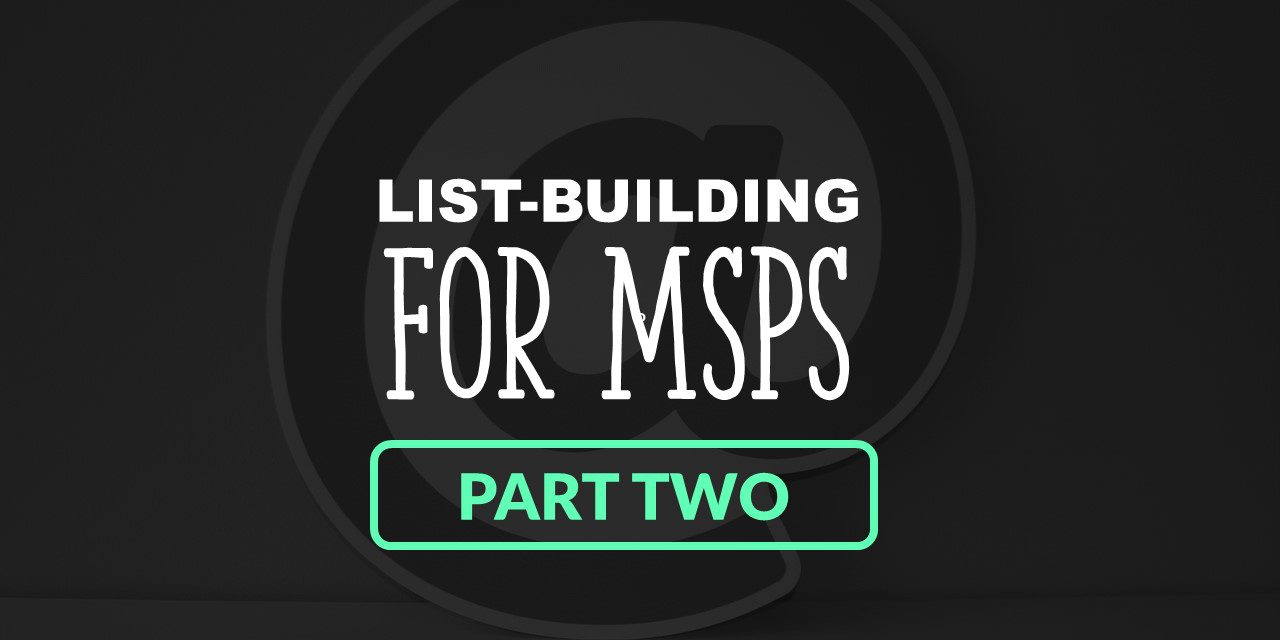How To Add More Contacts To Your List Through Opt-In Forms
In part one of our “List-Building for MSPs” series we talked about finding contacts that you may already have and adding them to an email marketing platform or CRM. The yield for this activity will vary based on how long you have been in business, how much you have networked, and how well you have recorded such sales activity. The next part of this process is all about adding new contacts to your list, now that you have established one. This is what we call “lead capture.”
Many Channel vendors will offer you free branded collateral to put on your website in hopes to help you build your list and sell more of their products. While this can be very beneficial in the right hands, simply slapping a form on your homepage and hoping it converts will likely yield few results. This does not necessarily make it a flawed strategy, it is simply an oversight of the details.
Opt-ins are achieved only when your visitors interest is piqued, and they are willing to offer something of value (their contact info) for more. Think of one of the best meals you have had in your life at a restaurant. You finish your entree and your stomach is 90% full, yet you have to order desert because the anticipation of what you will get is well worth the cost. Had you eaten a sub-par meal, you would likely take the check and leave with no desert, unwilling to invest any more than you have to in this underwhelming experience.
The Ultimate Guide To Cash Flow For Managed Services
Sponsored by Alternative Payments & Zest
Ingredients of a Successful Lead Capture
Successful opt-ins are achieved through the right combination of ingredients. It is less about the offer itself and more about what the visitor experienced leading up to the opt-in. There are four primary components to a lead capture that in combination will determine the overall success (or lack thereof). These are as follows:
Collateral
In order to achieve your goal of capturing a visitor’s contact information, you need to offer something of value in return. This is referred to as the “collateral.” The most common form of collateral used by MSPs today are eBooks, however these have become somewhat saturated and appear to be diminishing in value. The type of collateral that you offer is important and may prevent someone from opting-in, even if all of the other conditions are right for them to do so.
This is because people prefer to consume content in different ways. This is why you should always attempt to offer a mix of different collateral so that you can appeal to different segments within your audience. I personally am not an “eBook guy.” When I read books, they are always in paperback form and I typically order them from Amazon. No matter the topic, I likely would not download an eBook, simply because I know I would never read it.
That being said, I do attend quite a few virtual events and this is a medium of collateral that appeals to me. I would be substantially more willing to offer my contact details in exchange for an event invite than an eBook, even if they were on the exact same topic. For more ideas on different types of collateral, see our article about eBook Alternatives.
Placement
Going back to our analogy about your favorite dining experience, think about the placement as your entree. This is the meal leading up to desert. You want your audience to be “full” but not too full to the point where they are not seeking more. The quality and composition of this content will have a direct correlation to what the audience does next.
Now you can start to see why an eBook offer on your homepage likely does not convert. Homepages are notorious for having some of the highest bounce rates of any page on a website. You could almost make an argument that these are the least engaged visitors that you will have and it’s the last place that would expect someone to convert on an opt-in.
In theory, your website should attempt to pull your audience in, get them to engage with content that interests them, and then offer them an opt-in that is contextual to what they have just consumed. For example, if your visitor makes their way to one of your service pages about Email Security, this is the perfect place to offer them access to an Email Safety Manual that can be branded with your customer’s logo and sent to their employees. If this offer appeared on a page for Disaster Recovery, it would be less contextual and would not convert as well.
The Ultimate Guide To Cash Flow For Managed Services
Sponsored by Alternative Payments & Zest
Behavior
If you only had the option to order desert at the beginning of your meal, you would likely never order it. There are too many unknowns. How full will you be? What will you be in the mood for? Will the meal cost too much? This is why it has become a common behavior for restaurants to present these options to you after you have completed the majority of your meal, when the timing is right for you to make this type of decision.
The same is true about opt-ins and the behavior upon which you use to ask for them. Pop-ups, slide-ins and embeds are all just different ways to ask for the same thing. Each behavior is better suited for a specific scenario, which just like our collateral types, should be mixed in order to accommodate various segments.
For example, a mobile visitor is more likely to engage with a slide-in than a pop-up (which tends to be strongest performer for desktop users). Engaged users of your content would be more likely to opt-in to an embed positioned within the body of an article or page, than they would on the sidebar or other location. These various placements should be experimented and optimized to get the best performance possible, and going all-in on one or the other will lead to fewer results overall.
Traffic
If there is one takeaway from this, it should be that not all traffic is created equally. Some visitors do not convert and will never convert no matter how great your funnel is. When it comes to public facing internet (and especially company home pages), people are free to roam and they often do in very curious ways. If you aren’t generating traffic to your site via ads, targeted links, or social media, then it is likely that the majority of your visitors are “unintended” and are simply passing through.
These unintended visitors have varying motives. Some may be looking for employment, researching a popular topic, or were just curious about what they saw before they clicked a link to your site. From an analytical standpoint, these visitors may look the same as everyone else, but they will ultimately never add to your funnel and thus can be considered “vanity metrics.”
If you want to build a real list, it starts with bringing in legitimate traffic that you know fits the profile of a buyer of your services. Leaving this up to chance may produce a few lucky opt-ins, but it will likely not produce the sustainable growth that you need to nurture this list into opportunities. Here are a few of our favorite ad placements that MSPs should use to send traffic to their content.
To Be Notified About Future Posts In This Series, Subscribe Below.

SPONSORED BY ZEST

















